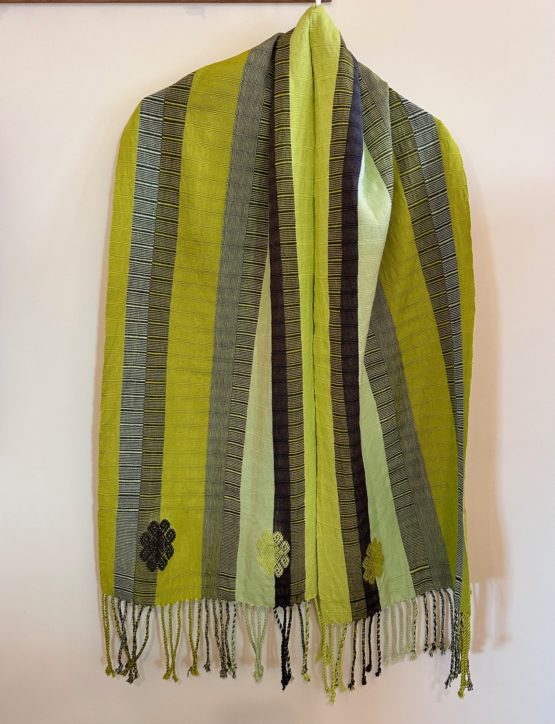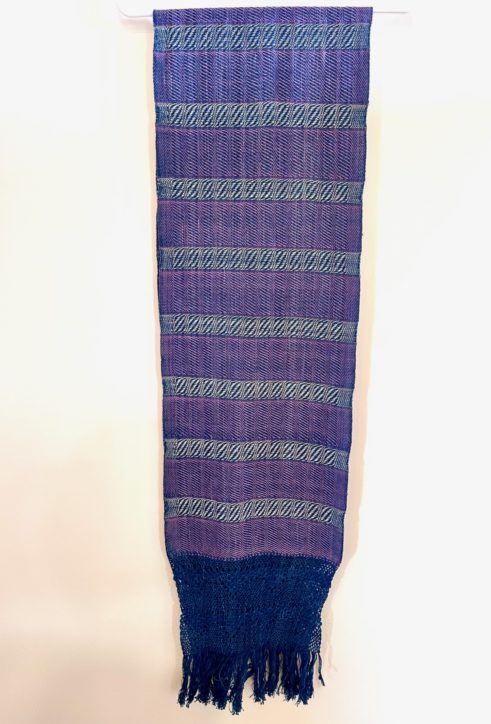In Oaxaca, indigo is cultivated in the hot, sub-tropical climate along the southern coast in a town called Santiago Niltepec on the Isthmus of Tehuantepec. A leafy plant, it is usually found in the band around the world along the equator. For example: Africa. India. Japan. South Carolina. There are exceptions, as this Indigo Around the Globe exhIbition at the Albuquerque Museum describes the works of Scott Sutton, who is growing and dyeing with indigo in Taos, New Mexico, where I live when I’m not in Oaxaca. Nikesha Breeze, also from Taos, explores her own identity through Negro Cloth, the root of American blue jeans.

I love indigo. I look for it and collect it. i wore an indigo tunic woven and dyed by Sebastiana Guzman in Pinotepa de Don Luis to my son’s wedding. My sister and I traveled independently to Japan in 2019 on a quest for indigo. Same when I went to Gujarat, India — I had indigo on my mind. I’ve not been to west Africa, but I know Gasali Adeyemo, originally from Kenya who now lives in Santa Fe. He makes stunning shibori cloth that is featured in this exhibition, and that he sells online and at the International Folk Art Market.
Indigo isn’t really a dye. It is a pigment. It adheres to the surface of a fiber — cotton, wool, silk, etc. and requires no mordant (fixative). It is used to stain wood and concrete, too. An indigo bath needs to be kept at 90 degrees Fahrenheit and the delicate process requires oxidization in order to work.

Indigo was the African cloth of royalty. It’s cultivation and harvest and transformation into a dye material was also dependent on the labor of African slaves who brought their knowledge to the Americas, exploited for economic gain by 18th and 19th century planters who exported it to England’s textile industry. At one time, indigo was the second most valuable export to Britain from the Americas.

In North and South Carolina, slaves were given indigo-dyed cloth to wear because of its durability and as a way to distinguished the enslaved from plantation owners. During the Civil Rights Movement, denim was reclaimed by African Americans who wanted to push against the pressure to dress in a way deemed “acceptable” by white peers.

in Japan, indigo jackets were worn by fire fighters because of its flame retardant properties. In the cold north islands cotton didn’t grow, so rough hemp was used to pad layered quilted fabrics that served as jackets and bed coverings. Known as boro, this cloth was pieced using salvaged indigo scraps, held together by stitches called sashiko, and handed down through the generations. A fashion born of poverty, it is now very collectible and priced in the stratosphere.
Early Navajo Dine weavers used indigo in the chief blankets they wove to keep them warm in harsh New Mexico winters.

In Oaxaca, my family, Fe y Lola Rugs, uses indigo in the rugs they weave. They prepare the dye bath and dye hand-spun organic churra wool yarn skeins in small batches to get the most intense color.
Our family also offers natural dye workshops that introduce people to the chemistry of indigo.

i found this exhibition beautiful, comprehensive and satisfying. If you are coming to New Mexico, don’t miss it. Thanks to Nancy Craft for suggesting that I see it.









Artist Laura Anderson Barbata from Brooklyn, NY, uses indigo-dyed cotton brocade, printed cotton and machine embroidery from Oaxaca, to create costumes for stilt dancers. We also saw her work a few years ago at the Museo Textil de Oaxaca.
On exhibit through April 24, 2022.
Yes! I’m now back in Taos. Still snow on the mountains.





























































Mascaras Mexicanas: Mexican Masks — Dances, Dieties, Identity
A new temporary special exhibition at the Palacio Nacional (National Palace) on the Zocalo in Mexico City features hundreds of hand-made masks from towns and villages throughout Mexico.
This is the same building that houses Diego Rivera murals, so if you go there soon, don’t miss this. Enter on side street through security, go to second floor.
I returned on my last day in the Federal District and spent about an hour-and-a-half learning more about Mexican art and culture. Open Tuesday through Sunday, 10 a.m. to 5 p.m.
In ancient civilizations one of the main functions of ritual masks was to represent gods to worship them in religious celebrations. This was designed to support natural and social equilibrium.
In pre-Hispanic Mexico, masks served as elements of transformation that allowed rulers and priests to assume the identity of their gods during ritual ceremonies. This helped bridge communication between the spiritual and natural world.
Sculptures, reliefs, murals and figurines from throughout Mesoamerica show ancient members of the elite personifying deities with the masks and attire that empowered them.
If you come with us on Looking for Frida Kahlo and Diego Rivera Art History Study Tour in February or March, you can drop in to see this show.
According to the exhibition curators, since the time of the Spanish conquest in 1521, the invaders prevented pre-Hispanic civilizations from freely practicing their religious customs. The conquistadores imposed their will by force. The Catholic religious friars sought to supplant native ancestral traditions by incorporating Christian ideas into native rituals.
Despite these efforts, pre-Hispanic symbols survived and indigenous people continue to observe their ancient religion under the veil of Catholicism. New masks arose from this cultural mixing (mestizaje) with an original combination of symbols that continue to the present in many regions throughout Mexico.
This provides continuity for ceremonial and celebratory traditions. Many communities throughout Mexico, such as Teotitlan del Valle, where I live, practice rites and dances like Dance of the Feather (Danza de la Pluma) from viceregal times in which costumes and masks play a central role in the celebrations.
The masks are handmade from gold, precious stones such as jade, turquoise, malachite and coral, wood, paper, straw, textiles and other materials. All the indigenous people of Mexico, including Aztecs, Mayans, Zapotecs, Purepechas and others used them.
Sacred dances in pre-Hispanic Mexico were ceremonies of invocation that found resonance in Catholicism as indigenous people were folded into the Spanish concept of small towns or barrios under the sponsorship of patron saints.
Indigenous people adopted and venerated these saint along with their own ancestors and pre-Hispanic deities. Friars promoted village feast days during the liturgical calendar and introduced morality plays. These were dramas based on sacred history and events that focused on the struggle between good and evil.
Often featured in these dances are masks representing Judas, Jews, Moors and the devil. The purpose of this was to instill fear and respect in the local population along with the message that they were defeated and obliged to strictly obey the new religion. I have no personal evidence today of any anti-Semitism in Mexico, that continues to welcome dissidents and disenfranchised.
We see in the Hall of Festivals at the Secretary of Public Education Building in Mexico City, many of these celebrations painted by Diego Rivera in his murals. Masks in this exhibit depict the Deer Dance from Sinaloa, also featured by Rivera.
La mascara posee un extraño poder de sugestiøn sobre la imaginaciøn … es la sintesis, la esencia de la deidad, del demonio, muerto o héroe qu se trata de representar. — Miguel Covarrubias
The mask has a strange power of suggestion on the imagination … it is the synthesis, and represents the essence of deity, demon, death or hero. — Miguel Covarrubias
The exhibition takes a step beyond the traditional to include the work of Mexican contemporary artists who work in various media. This painting (below) by Frida Kahlo, My Nanny and Me, is on loan for this exhibition from its home at the Dolores Olmedo Museum.
Evoking Frida Kahlo: Making Altars and Shrines Art Workshop
The painting is part of this exhibition because of the masked wet-nurse representing indigenous culture that provides sustenance.
Also included are the work of artists Francisco Toledo (paper mask) and Germån Cueto (wood mask), and painters and printmakers whose names I didn’t record (sorry).
Today, we often hide behind the mask we present to the world as a way of self-protection, self-preservation. In the days before the popularity of mask-wearing for Halloween, the mask was a symbol for deception, hypocrisy, and lies.
Like this:
6 Comments
Posted in Cultural Commentary, Travel & Tourism, Workshops and Retreats
Tagged art, culture, exhibit, Frida Kahlo, gallery, indigenous, masks, mestizo, Mexican, Mexico, Mexico City, mixed media, pre-Hispanic, Spanish, syncretism